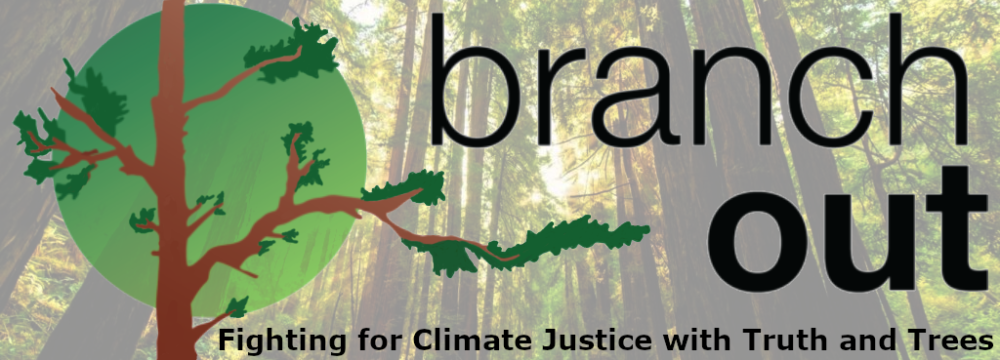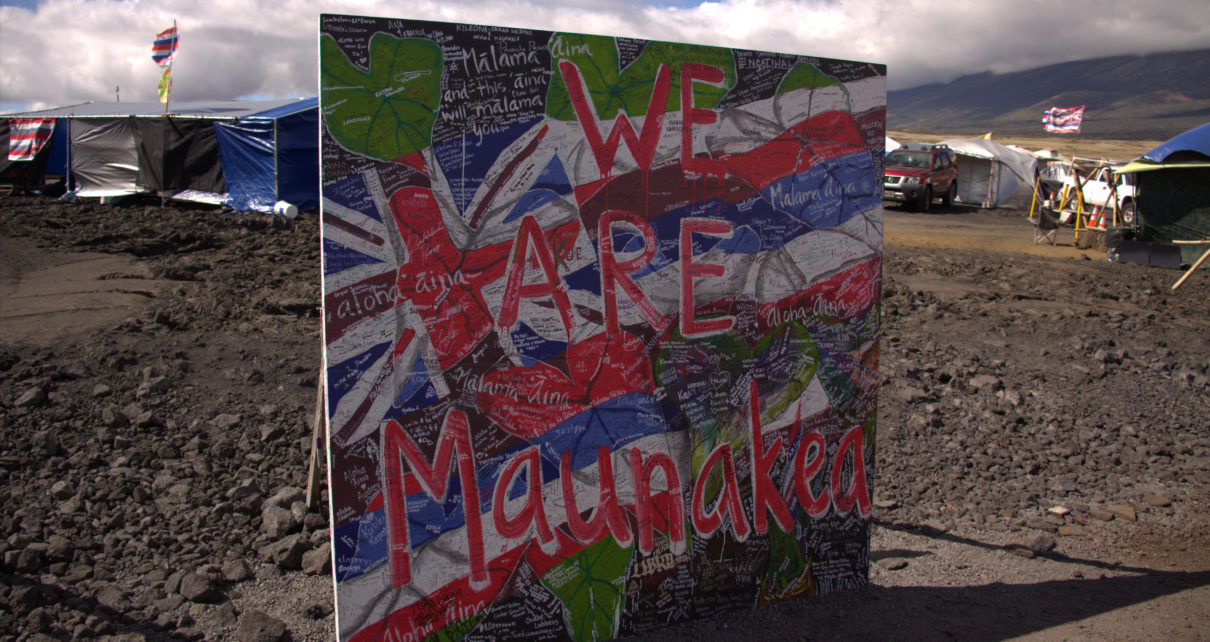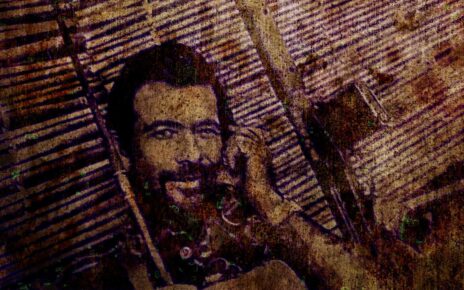‘From Maui to Mauna Kea’ is a multi-part series written between October 2019 and August 2020. In part one, I share my research on Hawaii, TMT and the US Military, plus my experience traveling off the beaten path around the islands and interviews I gathered along the way.
The world’s most controversial telescope is the Thirty Meter Telescope, TMT, which has been planned to be built atop Mauna Kea, the tallest peak of the Hawaiian Islands and sacred land to the Native Hawaiian people. When construction was set to begin more than a year ago in July 2019, it was met with mass resistance led by Native Hawaiians who refer to themselves as protectors rather than protesters. Far from being an isolated case of resistance to environmentally destructive and culturally insensitive construction, Mauna Kea has inspired environmental activism across Hawaii and the world, and it has brought increased attention to an international legal crisis that has been ongoing since at least 1893.
TMT is an international nonprofit project led primarily by the University of California, CalTech, and researchers from Canada, Japan, India and China, in partnership with the University of Hawaii. If completed, the Thirty Meter Telescope would be the fourteenth telescope located at Mauna Kea. According to some of the the protectors, many Native Hawaiians, and the Acting Council of Regency of the Hawaiian Kingdom, each one of these telescopes has been not only a desecration of sacred land, but the battle to protect the mountain has also been one ongoing part of a fight to enforce international law and the Hawaiian Kingdom law in the face of illegal occupation by the United States.
And it’s far from over. TMT spokesperson Gordan Squires told Hawaii News Now in July that they will try to break ground again in 2021. The telescope is owned and operated by a multinational partnership of academic and research institutions, with the University of California at the helm. The Daily Californian reported that at a July meeting of the UC Board of Regents, representatives from TMT told the board that they still prefer Mauna Kea as opposed to an alternate site of the Canary Islands in Spain. The project’s budget rings up to 1.4 billion dollars.
In October 2014, when I had started as a freshman at the University of California at Berkeley, TMT held a ceremony to begin construction that was interrupted by protectors. One of them, Lanakila Mangauil, addressed the TMT representatives as “snakes” in a viral speech recorded by Big Island Video News. Five years later, I would meet and interview Lanakila on the Mauna.
Construction of TMT had understandably been a divisive topic among UC Berkeley students and faculty throughout my time on campus. The telescope will allow humanity to look further into space than ever before, opening a window to outstanding scientific discovery. The planned location of Mauna Kea, however, angered many in the community including Native Hawaiians who have urged the UC System to divest from TMT, which has received $68 million dollars from the UC to date, according to The Daily Californian.
TMT should have been able to see this coming. All the way back in 2007, an independent research document from the Keystone Center assessed the potential risks of pursuing Mauna Kea as the site of the Thirty Meter Telescope. The report predicts mass resistance on behalf of Hawaiians for a number of reasons, including the fact that management of Mauna Kea has always been controversial, TMT is actually proposed to be built in a conservation zone, and the lease for the University of Hawaii to use the mountain for astronomy is actually set to expire in 2033.
Maui
When I stepped off a plane in Kahului, HI on September 30, 2019, TMT had become a worldwide controversy, with Mauna Kea becoming a symbol for indigenous resistance and environmental activism. At that time, I don’t think I really knew what that meant or how deeply within in a month’s time, my perspective on not only Mauna Kea but America would be shaken from its axis.
Despite it becoming global news over the summer, when I got to Maui, I heard surprisingly little about TMT. I would hitchhike from the farm I was doing a work stay at into the town of Paia. One local told me about the U.S. military base on Maui, and how military planes would land in Kahului, go down the runway and seem to disappear underground. I never verified this from anyone else or saw it with my own eyes, but this encounter tipped me off to the military presence on Hawaii that would repeatedly rear its head.
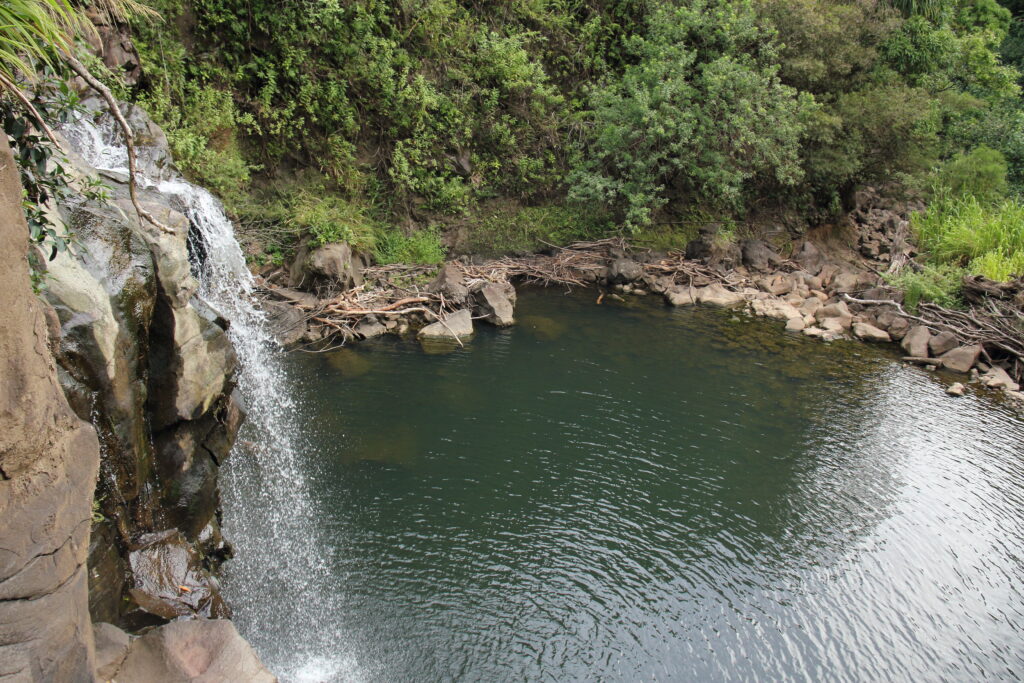
Kanaka is the Hawaiian word for a Native Hawaiian person. The only Kanaka I really talked to about TMT on Maui was a worker at the farm who we will call Lou. The first time Lou opened up about his concerns for the local community, he talked about the high cost of living due mostly to an influx of younger folks from cities like San Francisco. He said that over the next year the cost of living was expected to rise another 30%, a statistic that I could not verify.
One day I asked Lou what he thought about TMT and the Mauna Kea protectors. He said he thinks the protectors are “fucking idiots” and they are destroying the environment by camping at the base of Mauna Kea. He added that as long as it’s not destroying anything, he is fine with a telescope being built on the mountain. I couldn’t help but think Lou wasn’t fully aware of the size of TMT, but I decided not to push him on this answer because I hadn’t learned everything I could about the project yet either.
The Thirty Meter Telescope itself will take up 1.4 acres with another five acres of new roads and a parking lot. The telescope itself will rise 18 stories tall and two stories below ground. Some of the specific environmental concerns include threatening the habitat of the Wekiu bug, an indigenous insect that had been a candidate for the Endangered Species list, and potential water pollution and hazardous chemical spills.
Meeting Kale
The more I learned, I decided the best thing for me to do was relocate to the Big Island so that I could go up to Mauna Kea and see for myself. I rented a car from an app where someone picked me up at the airport and then I used their car for a few days.
The man I rented from was named Kale. He picked me up in Hilo, HI wearing a yellow shirt that says “Deoccupy Hawaii” in big black letters. I told him I was a journalist, and he said he is one of the people organizing to stop TMT. Sometimes journalists have to dig and dig to find the story, this time the story found me and the challenge would be wrapping my mind around what I would learn.
Kale gets going while we drive, saying that the rhetoric coming from the pro-TMT side is “garbage.” They say the telescope will bring jobs, but according to Kale most of the technical jobs go to people from out of the state or other countries, and it’s “locals that are being hired for sweeping and mopping floors.” He added that the native Hawaiians are sick of being told to compromise because the first 13 telescopes were a compromise, and he feels enough is enough.
It would take me awhile to understand what Kale said next: “the biggest issue is the overthrow of the Kingdom of Hawaii government.” The U.S. and the state of Hawaii have been breaking international law, and the Hawaiian Kingdom still exists, according to Kale, but the government has ignored these laws: “They’re moving on and pretending like it doesn’t exist.”
Imiloa
Kale invites me to a community meeting later that night. He drives me back to his house and I leave with the car, but I plan to come back later for the meeting. First, I headed to the University of Hawaii at Hilo where I visited the Imiloa Astronomy Center, which is part of the University of Hawaii. The University clearly is proud of Hawaii’s role at the forefront of astronomical research, with much of the museum dedicated to the history of the 13 telescopes already on Mauna Kea. This history does not include mention of Kanaka resistance to telescope construction.

I ask the staff if I can talk to anyone about TMT, and I get the chance to sit down with Kaiu Kimura, Executive Director of the Imiloa Center, who is Native Hawaiian. She tells me that Hawaiians feel a deep connection to Mauna Kea and these connections are not all the same. “In light of everything, it’s apparent that all these connections were not engaged in the process,” says Kimura.
Since she works at an astronomy museum that glorifies the telescopes on Mauna Kea, it’s unsurprising that Kimura sees a big positive impact that these telescopes could have. She says they provide great educational programs and “world-leading scientific endeavors” but she adds “For a majority of our community [Native Hawaiians], they haven’t had the opportunity to engage with the astronomy community that I’ve had.” And although she says some progress has been made in the past couple of decades to get more Native Hawaiians involved, she adds that “when astronomy first started developing Mauna Kea, there wasn’t much engagement with the community.”
As a museum director and a Native Hawaiian, Kimura can see clearly how divisive the TMT issue has been for the island. She is worried that it has worsened the relationship between the scientific community and Native Hawaiians. But she also feels hopeful: “TMT has helped to surface some deficiencies that need to be resolved.” She sees a way that the TMT controversy could “force everybody to get out of their box and think creatively and progressively about how we move forward.”
Community Meeting
Kimura has to go, so I get back in my car, stop for a bite to eat, and then head back to Kale’s house. When I arrive, a few minutes after six, the mood is warm and familial. People hug and kiss each other on the cheek as a greeting. The first thing they do when we all sit down is actually a Hawaiian language lesson from Kealii, who normally teaches kids. I participate in the lesson too, which includes learning a chant that gives an origin story for the Hawaiian islands. Kale hasn’t changed his shirt, and this time I can see that the back says “The Hawaiian Kingdom Still Exists.”
There are about fifteen adults and one young teenager in the room — sitting at the dining table, in stools at the kitchen counter, or on sofas in the living room. The home is clean with an open floor plan so we can all see each other. The group spans many occupations with a fisherman, a construction worker, a former welder and nightclub owner, several teachers, small business owners, a medical office manager, a certified public accountant, and an archaeologist all in attendance. A few people pop open a beer as the conversation moves to the serious topics at hand.
First, Kale stops to explain to me why they start with a language lesson: “The majority of us here grew up never being able to speak our own language.” In 1896, after the coup against Queen Liliʻuokalani, the newly established Republic of Hawaii passed a law making it a requirement that all schools taught lessons only in English. Children were often disciplined for speaking Hawaiian in schools. Not until recently has the Native language gained more prominence, so most of this group who are in their 50s and 60s are learning rudimentary Hawaiian language for the first time.
The group moves on to discuss “Crown Lands.” Under Hawaiian Kingdom law, Crown Lands were owned by the Monarch of the Hawaiian Kingdom and passed down from one monarch to the next. He or she could lease the land but legally could not sell it because it had to transfer ownership to the next monarch. Since according to those attending the meeting, the Hawaiian Kingdom never legally ceded lands to the United States, the summit of Mauna Kea still falls under the control of the Hawaiian Kingdom.
When I express my confusion over how the Hawaiian Kingdom could possibly lay claim to Mauna Kea, I am warned that in order to really tell the Hawaiian side of the story, I need to do a lot of research to know the context that has built up to the controversy over TMT. As I would later learn, stopping TMT was not this group’s principal goal. Their goal is to reestablish the government of the Hawaiian Kingdom.
I tell them how I visited Imiloa earlier. One attendee, Manu, who works at the University says “That whole building got built because our ancestors have gone and testified against every telescope they have.” Manu’s view is that buildings like Imiloa include Hawaiian cultural information to make native Hawaiians feel included, but they only perpetuate the underlying injustice: “Why do they even have this beautiful building. I’ll tell you why: because they’re trying to silence us.”
Manu makes it clear “There is no compromise in what we do.” The whole group is determined not only to fight to stop TMT, but to restore power to the Kingdom of Hawaii. “I think TMT is the straw that broke the camel’s back, and there is no compromising.” Her husband Dexter adds, “This is emblematic of distress with the system.”
A Brief History
At this point, I knew they were right about one thing; if I was going to tell this story, I needed to go way back. These next paragraphs are only what I thought were the most relevant parts of Hawaiian and American history to explain what I ultimately uncovered. Entire books continue to be written on this topic, so excuse me if I oversimplify anything, and more detail on the Hawaiian Kingdom can be found at hawaiiankingdom.org.
Hawaii is the westernmost corner of what is called the Polynesian Triangle, which encompasses the area of the Pacific Ocean between the Philippines, New Zealand and Hawaii. Radiocarbon dating establishes proof that humans inhabited Hawaii since at least somewhere between 100 and 800 CE, with a second wave settling the islands much later, circa 1219–1266, whose ancestors would create the Hawaiian Kingdom. The Polynesians were the most advanced astronomers of the region, using the night sky to navigate the vast Pacific Ocean.
The first Europeans to find the islands arrived in 1778 led by British captain James Cook. The Hawaiians were able to resist becoming a territory of Great Britain, and the islands unified under one nation as the Hawaiian Kingdom in 1810. The new nation was both a constitutional monarchy and a representative democracy. It established embassies in and treaties with other countries and had progressive land ownership laws (Kuleana Lands) designed to benefit Native Hawaiian people, while also welcoming outsiders to apply for citizenship.
In 1893 American businessmen, backed by the US Marines and led by US minister John Stevens, initiated a coup that overthrew Queen Liliuokalani’s government and they established what they called the Republic of Hawaii. The Queen appealed to President Grover Cleveland to intervene and help her regain power. Cleveland sent Congressman James Blount to investigate.
In his report, Blount found that not only had U.S. citizens conspired to overthrow Liliuokalani, but that the entire operation had been illegal. Cleveland then sought to restore the Hawaiian Kingdom, but many Americans had backed the coup and supported the Republic of Hawaii. At the time, the republic wanted to be annexed by the United States, so they found allies in Americans who wanted a foothold in the Pacific.
One ally was U.S. Senator John Morgan from Alabama. Morgan, a former Confederate general and Grand Dragon of the Ku Klux Klan, made his own report to contradict the Blount report, allegedly because he wanted to deport the entire Black population of the U.S. to Hawaii. Although the Senate never approved Morgan’s report, it provided a strong enough counternarrative to sow doubt in Blount’s account of the coup.
The following election, Cleveland lost the Presidency to William McKinley, who was more of an imperialist. The Republic of Hawaii had previously agreed to an Annexation treaty with the United States, but the U.S. had been divided and congress voted it down. But the Spanish American War started in 1898, swaying public opinion toward Annexation as more Americans came to believe in the importance of having a military presence in the Pacific.
All the while, Kanaka who wanted the restoration of Queen Liliuokalani and the Hawaiian Kingdom government were strongly against annexation. A group called Hui Aloha Aina sent the Kue Petition against annexation to the United States with the signatures of a majority of Hawaiians.
The United States ignored these pleas and passed the Newlands Resolution in 1898, the same year that they invaded and imposed martial law on the Philippines. Most U.S. history books say that the Newlands Resolution made Hawaii a territory of the United States, but it was not a formal treaty of annexation between two nations, but rather a joint resolution of the United States congress asserting their jurisdiction over another country. The lack of an annexation treaty is what Kale and others point to as the reason why the Hawaiian Kingdom still exists, but it is under U.S. occupation.
Another U.S. joint resolution that Kale pointed me to is the 1993 Apology Resolution, which passed through congress and was signed by President Bill Clinton on the 100th anniversary of the overthrow of Queen Liliuokalani’s government. The resolution clearly states that the 1893 overthrow was illegal, that it suppressed Native Hawaiian sovereignty, and it calls for reconciliation between the United States and Native Hawaiians, but it does not explicitly recognize the Hawaiian Kingdom’s continued existence, which has led some to criticize it as a “red herring” (more on that in part 2).
Military Occupation
Following the Newlands Resolution, the United States began establishing their military presence on Hawaii. The Spanish-American war provided the initial urgency for the U.S. to establish military bases on the islands. This need became enshrined in the American psyche following Pearl Harbor and the fight with Japan in the Pacific during World War Two.
Kahoolawe is the smallest island in the Hawaiian islands. During WWII, martial law was declared on Hawaii, and the U.S. Military used Kahoolawe as a bombing ground to test ammunition and conduct target practice. After the war ended, the bombing did not. In the ‘70s, a group of Hawaiians began attempting to take the island back by landing their boats there. George Helm and Kimo Mitchell eventually died in these efforts, when their boat was never seen again. The Protect Kahoolawe Ohana, PKO, eventually succeeded and helped spur what is known as the Hawaiian Renaissance. But it took a long time, as the U.S. military did not end live-fire training on the island until 1990, and the island was not returned to the state of Hawaii until 1994. A five-year cleanup to remove any unexploded bombs or other hazards from the island concluded in 2003, but danger remains.
On Oahu, the valley of Makua has also been the site of bombing and live ammunition practice by the military. The group Malama Makua formed in 1996 to put an end to military occupation of the sacred valley and return Makua Valley to what they call “culturally appropriate use.” The valley is also home to endangered plant and animal species and more than 100 cultural sites, according to malamamakua.org
Just miles east of the Mauna Kea access road camp, the Pohakuloa Training Area is the largest military installation anywhere in the Pacific. Pohakuloa has also been the subject of intense criticism by Native Hawaiians and environmental advocates due to extensive bombing destroying the land.
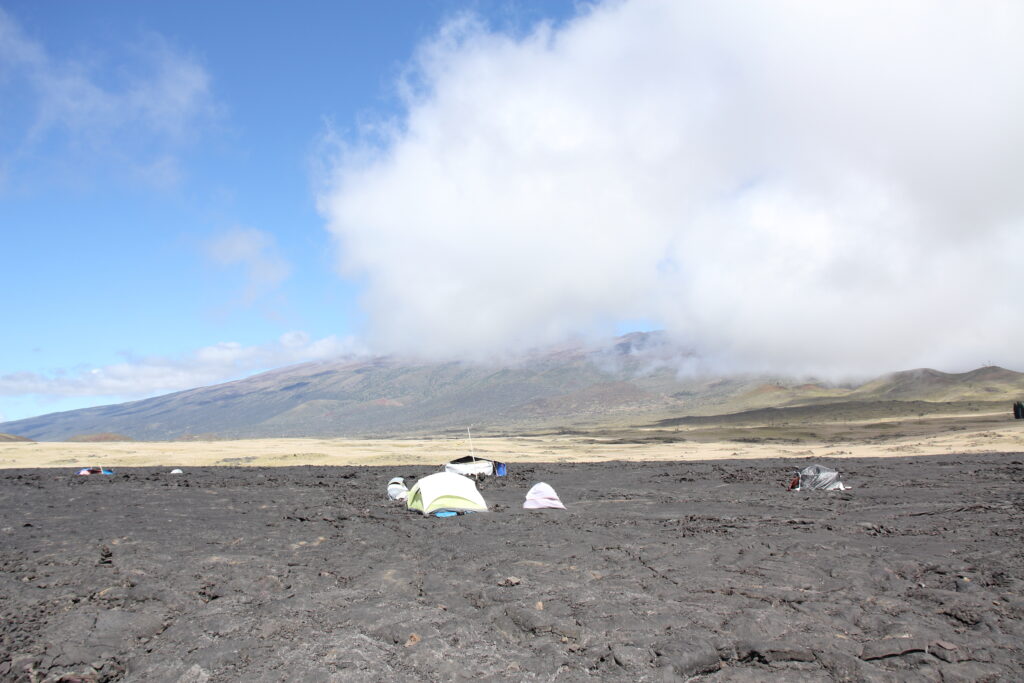
Seeing Mauna Kea
The morning after the community meeting, I spent a few hours touring the coast north of Hilo.
As I walk the trail of Akaka Falls and then see the pristinely kept botanical garden, I can’t help thinking that there are two Hawaiis. There’s the seemingly beautiful but whitewashed Hawaii that most tourists find visiting places like these, but for those willing to go beyond the surface, there is a Hawaii where the oppression of Hawaiian culture and subjugation of Hawaiian people is clear as the Maui beaches on a bright sunny day.
By mid-afternoon, I am driving up Highway 2000 where the camp blocking the Mauna Kea access road is located. It’s foggy and drizzling and I can’t see the mountain at all, but on all sides of me trees sprout from dark gray volcanic rock. There are Ohia Lehua trees, which hold a special place in Hawaiian religion. It is said that picking the Lehua flowers will bring rain – representing the tears of Ohia and Lehua, who were turned into a flower and tree by Pele, the Hawaiian volcano Goddess, because Pele also loved Ohia and had become jealous. Today, the trees are threatened by Rapid Ohia Death which is caused by a vicious form of fungus suffocating the plant.
I keep driving, eventually reaching a break in the clouds where I can see the sky on the west side of the big island. Turning the corner, the camp comes into view. There are at least 100 different structures spread on both sides of the highway. Volunteers stop traffic to allow protectors and visitors to cross the highway.
After proceeding through the intersection, I park on the outskirts and after asking where I should go as a journalist, I am eventually directed to the Information Tent, where I speak with Presley Kealanuhe Ah Mook Sang, a Native Hawaiian woman and Chancellor of Pu’uhuluhulu University, a university she helped establish at the camp.
Mook Sang said she has “A responsibility to be here because I am genealogically connected to this land.” She goes on, “I don’t really have a choice, it’s who I am and it’s what I’m supposed to do for my current generation and the generations to come.” While the folks at Kale’s community meeting were fighting for Hawaiian sovereignty, Mook Sang emphasizes that right now she is fighting to stop TMT, and although there are other important issues for Native Hawaiians, her goal for being involved is to stop TMT.
Meeting Lanakila
I decide to stop by the University across the highway, where 30-40 people of all ages are gathered around Lanakila Mangauil, who is telling a story about a ceremonial prayer-run he participated in that helped spur the resistance to TMT.
I sit down with Mangauil, who tells me that the run was “gifted to us by the Pit River Nation of Northern California,” and it is essentially “a prayer for the health of the land and the people of Hawaii”. He is also Native Hawaiian, or Kanaka, and is a teacher of Hawaiian history and culture. He describes himself as one of the “main instigators” to stop TMT because when construction was set to begin in 2014, he went on facebook and got people who were part of the prayer run to come block the road.
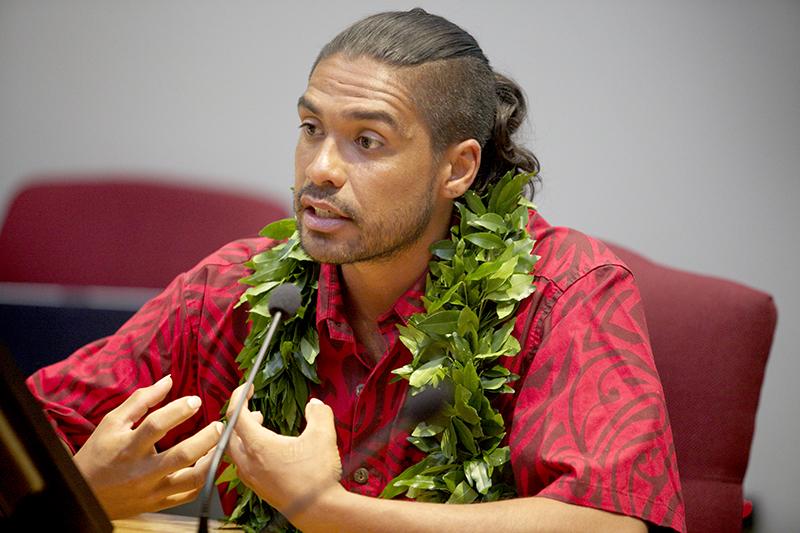
Afterward, there was a delay in which TMT was held up in a new permitting process with the state of Hawaii, but ultimately the project was granted permission to proceed once again. The current camp started over the summer of 2019, when Mangauil was one of many who helped galvanize Native Hawaiians and their allies to block construction. According to Mangauil, in the first few months there were never less than 1500 people staying around the Mauna Kea access road, and at the high points, there were seven to eight thousand people gathered. When I visited in October, there were a few hundred people at the camp. “We have used this as an opportunity for people to rest,” said Mangauil.
I told him a little bit about my experience the previous day at the community meeting and asked him if this is about the Thirty Meter Telescope only, or if he specifically wants to see power returned to Hawaiians. He explains that my question frames a false dichotomy because both issues are irreparably intertwined in Mangauil’s view:
“It’s [construction of TMT] a symptom of the lack of Hawaiian sovereignty, but you cannot separate the two because our culture is an intrinsic part of the environment. So we’re talking about our environment and our sovereignty, being able to live based on our culture under our rules and governance… because our governance is ruled by the care of land. So that’s one of the things we are trying to speak to, because in the western world there is a separation between humans and nature that does not exist in our reality. We are part of nature. … Under a Hawaiian government, there’s no way we would be doing this because our government, our Hawaiian consciousness of our culture and how we would govern and how our people did govern for thousands of years protected these places. So it goes hand in hand, there’s no one or the other. Any and all Hawiaan struggles are environmental struggles – they’re the same thing.”
He explains that regardless of the legal legitimacy of the state of Hawaii, Kanaka are fed up with the state succumbing to outside influence instead of helping its people. Many of the telescopes are operated by foreign governments, each competing to make the next big discovery. “Our sacred spaces are where their games are played,” he said.
The Ala
It is approaching 5:30 p.m. when the camp comes together for what they call a protocol. Lanakila takes over the drums while another of the leaders grabs a microphone to lead the ceremony. Everyone gathers on what they call the “ala” which is on the access road facing where the kupuna stay. On one side are about 25 flags from different nations, showing how many people have come to show solidarity with Mauna Kea protectors. On the other side are a line of portable restrooms and two murals.
The hula is a form of prayer, song, and dance all rolled into one. The spiritual energy that each participant brings to the protocol is something that cannot be adequately described in the English language. Only by visiting Mauna Kea can one feel the energy on the ala. The protocol lasts until the sun has fully dipped below the horizon and the last orange glimmer of sunset has become a tiny stripe in the mist.
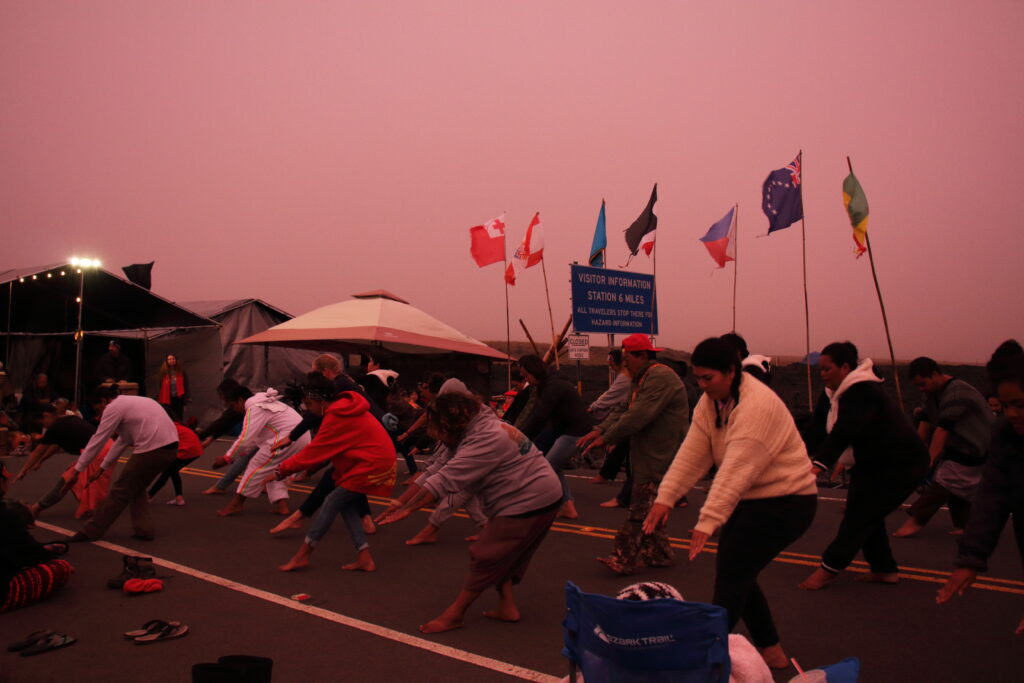
I find Lanakila Mangauil again as he finishes eating. The camp has a large kitchen tent, a medic tent, a solar power station, portable restrooms, and everyone takes turns cooking the night’s meal, which is spaghetti, a salad, and breadfruit. I tell Lanakila about the Hawaiian I met on Maui who called the protectors “fucking idiots” and said they were destroying the environment by being there.
“It’s hypocritical to point at us who are taking up space,” he said, assuring me that they also do everything they can to leave no waste on the mountain. He adds that if someone is worried about the environmental impact of the camp, then they should be far more worried about a massive telescope at the very top of the mountain.
Another common narrative that the media has put forth is that the protectors are somehow anti-science, which Mangaul says is “one of the most ignorant things” that he has heard. Firstly, because astronomy is only one branch of science and the type of astronomy that relies on massive land-based telescopes is only one type of astronomy. “We don’t have anything against astronomy. It’s about the construction of a building. That’s the problem … regardless of what is being built. It could be the Sovereign Kingdom of Hawaii trying to build a Hawaiian temple up there and I would fight them too. You do not do that.”
The drive to resist the desecration of Mauna Kea can be summed up in the phrase “Aloha ʻĀina” which translates “love of the land” and describes the deep connection between the Hawaiian people and the islands. I asked about how Mangauil views the difference between his connection to the land and the way the relationship between humans and their environment is viewed in Western culture.
“It [Western imperialism] definitely was designed to destroy the connection … pulling the kanaka away from connecting with the land under sacred understanding of symbiotic relationship was a tactic in order to separate them, so that then the foreigners could obtain these places to exploit it. It’s driven by the same sickness that’s affecting every community. It’s colonialism, colonization for the purpose of extracting resources to exploit for consumer and capitalist gain.”
The process of exploitation may have begun with Captain Cook and accelerated with the overthrow of the Hawaiian Kingdom government, but it is far from over, with Mauna Kea becoming the latest battleground. One common argument for TMT has to do with the jobs it will bring, and the fact that if TMT is cancelled, it may have a ripple effect where Hawaiians successfully protest other development projects and hurt the business community. Mangauil also responded to this directly:
“Let Hawaii be known as a bad place for business if you are a bad business. If you think you’re gonna come over here and get a red carpet so you can exploit our resources, exploit our people, we will run your ass out of here. We’re not afraid to stand up and run your ass out of here. And they’re mostly worried about the transplants – a lot of these wealthy people who have come in because ain’t no affordable housing being built here. We’re all getting priced out of our homelands. Just recently a study came out [saying] $90,000 dollars a year is considered low income in Honolulu, that’s how ridiculous gentrification has been and the driving up [of] prices. … Basically pricing the local people out of Hawaii. … And of course you have major major institutionalized racism here in Hawaii.”
At this point, I could tell things at the camp were winding down. People had finished eating. When we started talking it was loud with many people around chatting, but now there were only a couple of small groups around, so I decided to wrap the interview up and let Lanakila Mangauil continue his evening. I asked what people back in my home of California or the rest of the United States could do to help. He said talking and learning about the struggle is a great first step, but he went on:
“Boycott Hawaii. We’re all about it. Boycott us. Let them feel the pressure and boycott because you don’t want to support industries and governments that are not taking care of Hawaii. Trust me, most of the money that’s coming into tourism is not coming down to us, it’s not coming to our communities. We get the scraps and the filthy rich hold up the money. Most of the tourism businesses are not locally owned. They’re either foreign investors and or transplants. And somehow they always control the business and the brown people just work for them.”
“Everybody has a stake in this,” he said. According to Mangauil, Mauna Kea could set an incredible precedent for environmental movements around the world. In fact, he said it already has because some of the first protesters at Standing Rock were Hawaiians, and the movement against the Dakota Access Pipeline came to fruition after the 2014 protests at Mauna Kea. Every environmental movement could learn from the spirit of Kapu Aloha, and if the movement continues to be successful in stopping TMT, the eventual ripple effect could be enormous. “Every person on the planet should be paying attention to what’s happening in our community.”
